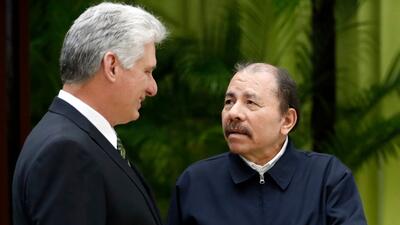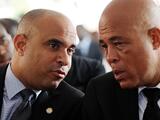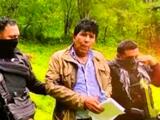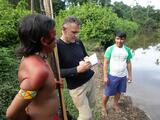A migration timebomb? What's behind Nicaragua's announcement to allow Cubans to enter without visas?

The surprise announcement last week by Nicaraguan leader Daniel Ortega to open his borders to Cubans without visas is sending shock waves through the region and could signal a new immigration headache for the Joe Biden administration.
The move appears to be a diplomatic blackmail by Ortega and Cuban leader Miguel Diaz-Canel in retaliation for U.S. sanctions against their widely repudiated regimes, according to some analysts.
It comes less than a month after Ortega was reelected president in a “sham” election, and less than five months after a day of unprecedented, spontaneous anti-government protests in Cuba that shook the island’s long-ruling Communist Party.
The official press release on Nov 22, announced the measure, which went into effect immediately, as a response to commercial, tourist “and humanitarian family ties.”
Another Mariel?
Veteran Cuba analysts say it has all the makings of a well-tried Cuban government strategy to create an escape valve for mounting political pressure on the island. It recalled similar occasions, such as the 1980 Mariel boatlift when Cuban leader Fidel Castro allowed tens of thousands of discontented Cubans to flee the island by boat. More recently, in 1994, Castro lifted travel restrictions to allow tens of thousands more Cubans to take to sea in in flimsy rafts in a dash to cross the perilous Straits of Florida.
“The official explanation isn’t very convincing. It looks like a ploy to allow Cubans to travel to the United States,” said Jorge Duany, a Cuban migration expert at Florida International University (FIU) in Miami. “Cuban migration is so cyclical that there’s a crisis every 15 years. There is a pent-up demand in Cuba to travel and migrate that hasn’t been met,” he added.
So far, the Cuban Ministry of Foreign Affairs has not commented on the matter and neither has the official Cuban media.
Duany and others point to multiple factors such as 18 months of covid-19 travel restrictions as well as the closure of the U.S. consulate in Cuba in 2017 in the wake of the so-called ‘sonic attack’ on U.S. diplomats, which remains unresolved. As a result, the Cuban tourism industry, the island’s main foreign currency earner, has been shut down, severely damaging the local economy.
On top of that, Cuba’s state-controlled socialist economy, restrictions of private sector capitalist enterprise, and an unpopular currency devaluation last December, have made the lives of ordinary Cubans even more miserable.
The announcement could have several motivations for both countries, according to independent journalist Reinaldo Escobar, editor-in-chief of the Cuban digital media 14 y Medio. Among them, "to provoke an increase in the migratory crisis on the southern border of the United States and thus force Joe Biden's administration to open a channel of negotiations with Cuba," he said in an interview with Confidencial, an online Nicaraguan media outlet.
"A flood"
U.S. officials in the region are bracing a possible new wave of Cuban migrants. “There is already a huge number coming through walking, hitchhiking up from Colombia. This will mean a flood,” said one U.S. official.
The Biden administration could try and pressure Honduras, Guatemala and Mexico not to let them through their territory, coupled perhaps with strict enforcement of asylum rules for Cubans at the border.
"It could be. I see a possible catastrophe at the border," Wilfredo Allen, a Cuban American immigration attorney in Miami.
The Biden administration has said little publicly about a potential for mass Cuban migration. "Each country has the right to determine requirements for international travelers to enter its territory," a State Department spokesperson told Univision via email. "We defer to the Nicaraguan government as to the reasons they made the decision to eliminate the visa requirement for Cuban citizens," the spokeserson added.
Belarusian ploy
The announcement also echoes a strategy adopted recently by the leader of Belarus, Aleksandr Lukashenko, using Syrian and Iraqi refugees as pawns in an effort to pressure the European Union over sanctions.
Coincidentally, senior Nicaraguan and Belorussian officials met in October for talks to highlight the solidarity of countries who are subject to Western sanctions.
Last month, Lukashenko congratulated Ortega on his controversial reelection, saying he hoped “to expand and strengthen” their friendly relations.
Asylum
Cubans fleeing communism have historically enjoyed highly favorable immigration treatment in the United States, including almost automatic residency if they enter the country legally. But, in order to gain entry they must still present a plausible, case of persecution based on politics, religion or gender.
The Biden administration this week reached a deal with the Mexican government to restart the Trump-era ‘Remain in Mexico’ program that requires asylum seekers to wait outside U.S. territory while their claims are processed.
Florida Senator Marco Rubio, the son of Cuban parents, has been warning for several months of a second Mariel-like mass exodus orchestrated by the Cuban regime.
"The Ortega-Murillo regime is aiding the Cuban dictatorship by eliminating visa requirements to instigate mass migration to our southern border," he told Univision.
"The Biden administration must respond quickly and take this for what it is: a hostile act," he added.
Few flights
It’s still too early to predict how many Cubans might take advantage of the new migration opportunity, experts say. For one thing, there are so few flights currently available between Cuba and Nicaragua it is virtually impossible for those wishing to travel. The only airline currently offering a connection between Cuba and Nicaragua, via Panama, is Copa, the Panamanian airline, at sky high prices in excess of $1,000.
Direct flights from Managua to Havana continue to be suspended due to the pandemic. But that could change if Cuba and Nicaragua have the political will to facilitate the journey, possibly with the help of their socialist ally, Venezuela.
There is no question that the demand is there. Protests were reported last week at commercial travel ticket sales offices because there were no flights available to Nicaragua. "This is a sign rather than a response to the enormous interest this issue has aroused," said Escobar, noting that the conditions that sparked the July 11 protests have not gone away and if anything have only gotten worse.
"The conditions that brought that about not only continue, but have been getting worse. Prices continue to go up. MOney is worth due to rampant inflation and shortages," he said.
Escobar described that July 11 protests as "a trauma for the Cuban rulers", creating the need for extraordinary measures to relieve the internal pressure.
Escape valve
"Then the government may fear that these kinds of demonstrations will happen again and the migration [escape] valve, as we call it, the migration bomb, becomes an option," he said. "It's like reducing the build up [of steam] in the pressure cooker, which is pretty high right now, especially among the most discontented," he added.
Rumors are rife of a possible airlift of multiple daily flights entre La Habana y Managua with the help of Venezuela.
That would also require Nicaragua to create some kind of logistics mechanism to handle the flow of large numbers of passengers, providing them with temporary shelter before busing them to the border with Honduras.
“They will need a lot of money to pay for the flights and the coyotes to get through Central America and Mexico to the U.S. border, said Allen.
In the past, desperate Cubans have tried to make the roughly 700-mile journey to Central America by boat, via the Cayman Islands, often with tragic consequences. In one especially tragic incident in 2014, only 15 Cubans on a boat with 32 people made it to Mexico alive after three weeks without food and water.



